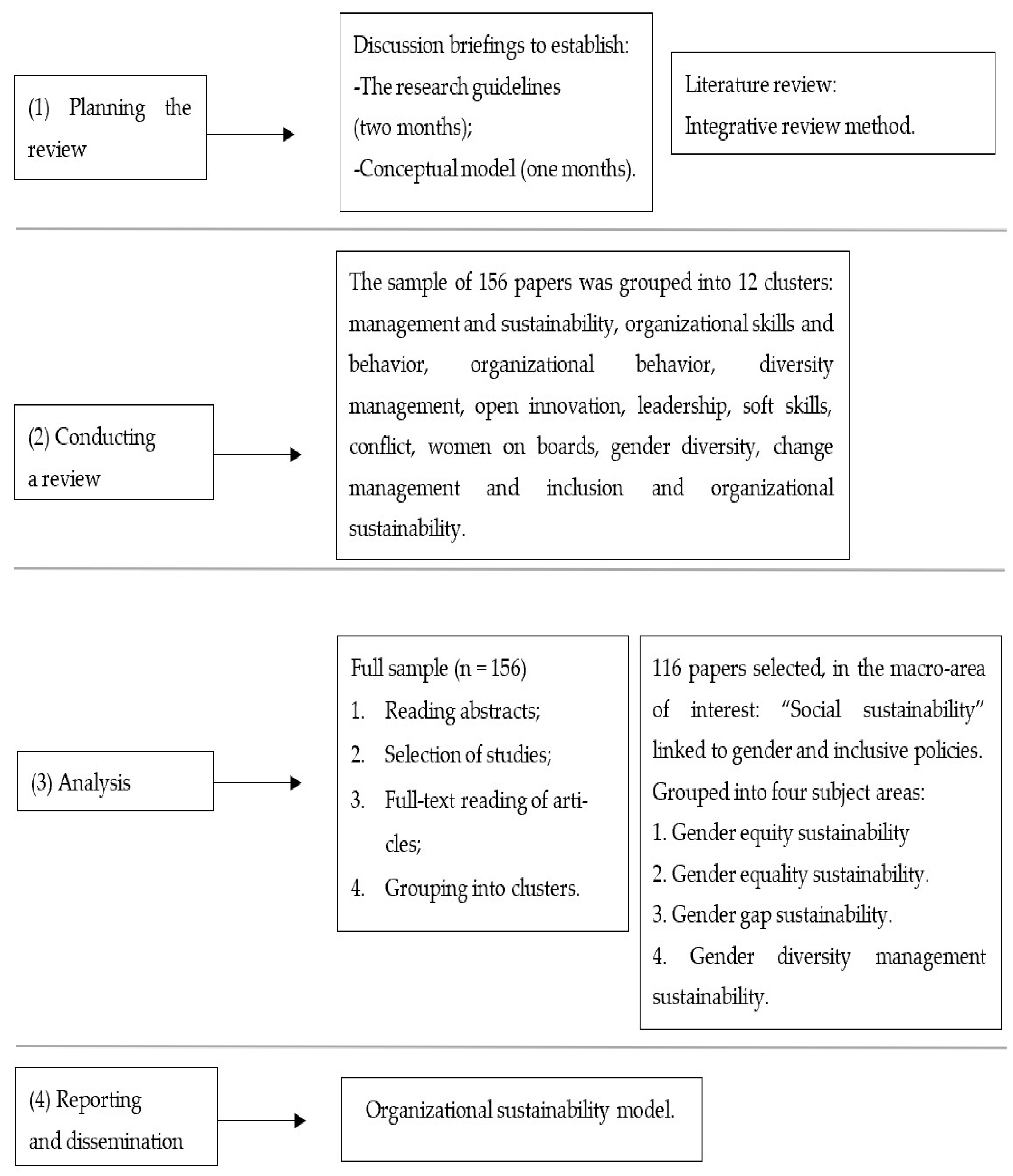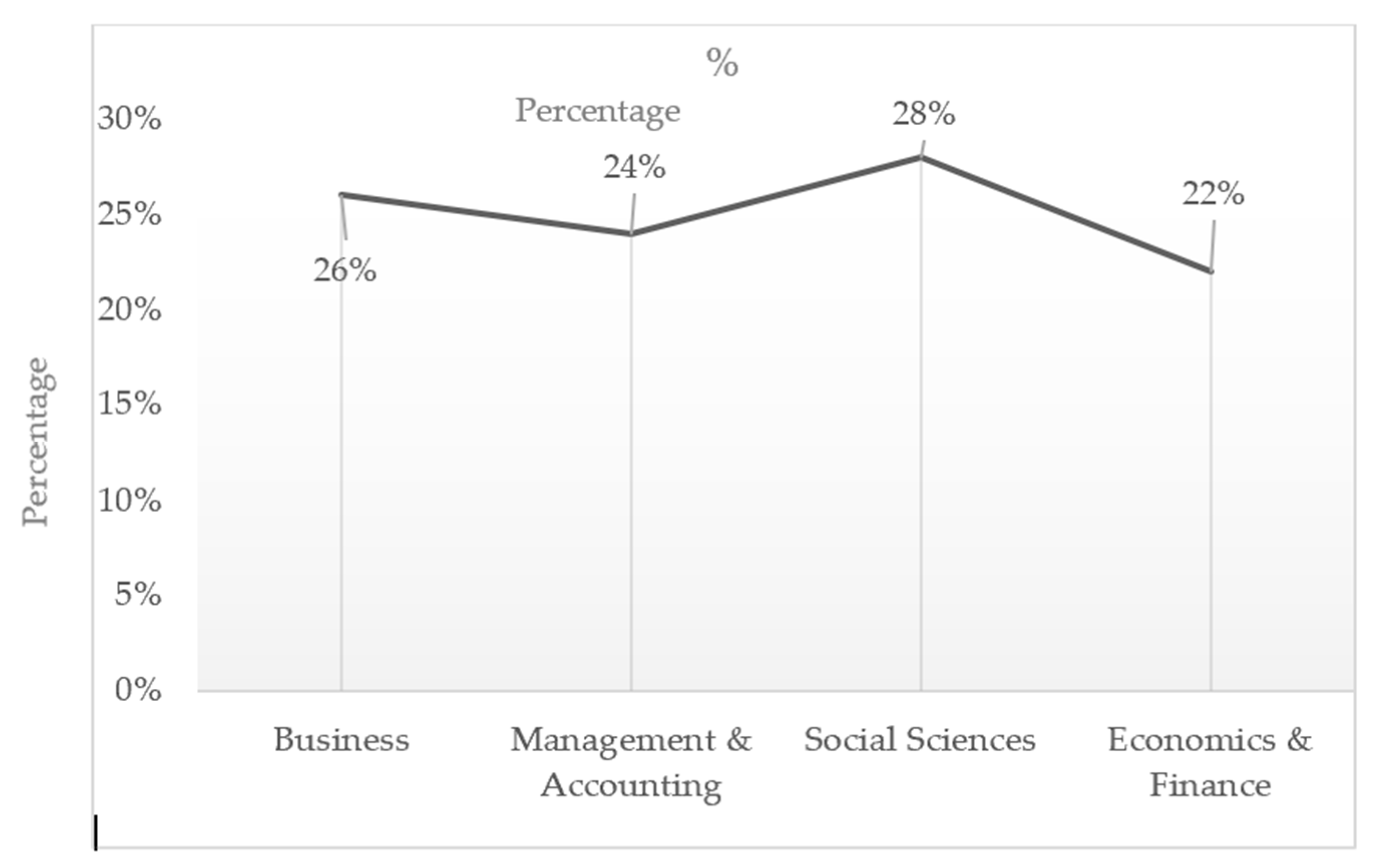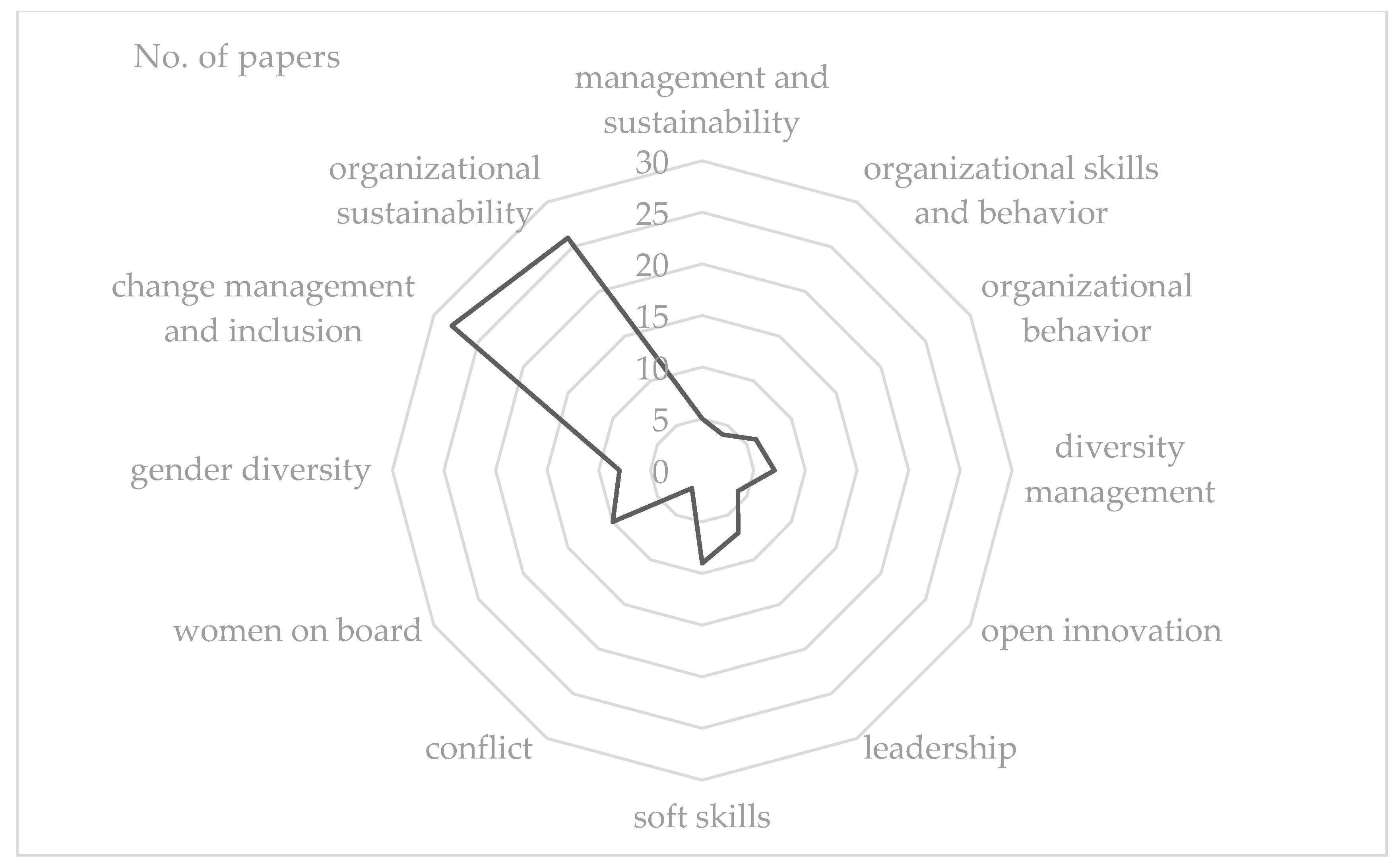Gender Diversity: An Opportunity for Socially Inclusive Human Resource Management Policies for Organizational Sustainability
Abstract
1. Introduction
Gender Diversity: A Matter of Equity and Equality
2. Research Design and Method
Analysis
3. Findings and Discussion
3.1. Gender Equity Sustainability
3.2. Gender Equality Sustainability
3.3. Gender Gap Sustainability
3.4. Gender Diversity Management Sustainability
4. Limitations and Future Perspectives
- -
- How do corporate policies influence gender equity and sustainability, particularly in the context of hybrid–fluid work?
- -
- What impacts does gender diversity have on sustainability in a flexible work environment, and how can we improve corporate management for more effective and inclusive sustainability?
5. Conclusions
Author Contributions
Funding
Institutional Review Board Statement
Informed Consent Statement
Data Availability Statement
Conflicts of Interest
Appendix A
| Search Variables | ||
|---|---|---|
| Date | Search Fields/Keywords | Databases: |
| from 2002 to 2022 |
|
|
References
- A/RES/70/1 Assemblea Generale Settantesima sessione punti dell’agenda 15 e 116 Distr.: Generale 21 ottobre 2015. Trasformare il nostro mondo: L’Agenda 2030 per lo Sviluppo Sostenibile. 2015. Available online: https://unric.org/it/wp-content/uploads/sites/3/2019/11/Agenda-2030-Onu-italia.pdf (accessed on 1 May 2022).
- Altman, Elisabeth J., Jeff Schwartz, David Kiron, Robin Jones, and Diana Kearns-Manolatos. 2021. Workforce Ecosystems. A New Strategic Approach to the Future of Work. MIT Sloan Management Review and Deloitte 62: 1–4. [Google Scholar]
- Baumeister, Roy F., and Mark R. Leary. 1997. Writing narrative literature reviews. Review of General Psychology 1: 311–20. [Google Scholar] [CrossRef]
- Bendl, Regine, Alexander Fleischmann, and Angelika Schmidt. 2019. Taking Care of Everybody? Alternative Forms of Organizing, Diversity and the Caring Organization. In Business Ethics and Care in Organizations. Edited by Marianna Fotaki, Gazi Islam and Anne Antoni. London: Routledge, pp. 264–79. [Google Scholar]
- Boudreau, John, and Jonathan Donner. 2021. Are You Ready to Lead Work Without Jobs? MIT Sloan Management Review 62: 1–5. Available online: https://sloanreview.mit.edu/article/are-you-ready-to-lead-work-without-jobs/ (accessed on 1 November 2022).
- Burton, Richard M., Dorthe D. Håkonsson, Marcello Martinez, and Børge Obel. 2020. Organizational Design: Principi e metodi per l’adeguatezza dell’assetto organizzativo aziendale. Torino: Giappichelli. ISBN 9788892135116. [Google Scholar]
- Caligiuri, Paola, Helen De Cieri, Dana Minbaeva, Alain Verbeke, and Angelika Zimmermann. 2020. International HRM insights for navigating the COVID-19 pandemic: Implications for future research and practice. Journal of International Business Studies 51: 697–713. [Google Scholar] [CrossRef] [PubMed]
- Capezio, Alessandra, and Astghik Mavisakalyan. 2016. Women in the boardroom and fraud: Evidence from Australia. Australian Journal of Management 41: 719–34. [Google Scholar] [CrossRef]
- Capgemini Research Institute. 2020. The Fluid Workforce Revolution. How a Blended Workforce Strategy Is Key to Success in the Age of AI and Automation. Available online: https://www.capgemini.com/insights/research-library/fluid-workforce/ (accessed on 1 January 2023).
- Catalano, Ralph. 1991. The health effects of economic insecurity. American Journal of Public Health 81: 1148. [Google Scholar] [CrossRef]
- Catalano, Ralph, Raymond Novaco, and William McConnell. 2002. Layoffs and violence revisited. Aggressive Behavior 28: 173–256. [Google Scholar] [CrossRef]
- Cervia, Silvia, and Rita Biancheri. 2017. Women in science: The persistence of traditional gender roles. A case study on work–life interface. European Educational Research Journal 16: 215–29. [Google Scholar] [CrossRef]
- Cicellin, Mariavittoria, Mario Pezzillo Iacono, Alessia Berni, and Vincenzo Esposito. 2015. Dealing with resistance in temporary agency nurses: The role of fear in identity-building processes. Journal of Health Organization and Management 29: 298–316. [Google Scholar] [CrossRef]
- Clarke, Marilyn. 2011. Advancing women’s careers through leadership development programs. Employee Relations 33: 498–515. [Google Scholar] [CrossRef]
- Colombo, Massimo, Marco Delmastro, and Larissa Rabbiosi. 2007. “High performance” work practices, decentralization, and profitability: Evidence from panel data. Industrial and Corporate Change 16: 1037–67. [Google Scholar] [CrossRef]
- Combs, James, Yongmei Liu, Angela Hall, and David Ketchen. 2006. How much do high-performance work practices matter? A meta-analysis of their effects on organizational performance. Personnel Psychology 59: 501–28. [Google Scholar] [CrossRef]
- Cueto, Dolores Rando, Carmen Jambrino-Maldonado, Gloria Jiménez-Marìn, and Patricia Iglesias-Sànchez. 2023. Exploring the domain of relationship between happiness management in organizations and the environment. Management Decision. e-pub ahead of printing. [Google Scholar] [CrossRef]
- Davis, Jacqueline, Kerrie Mengersen, Sarah Bennett, and Lorena Mazerolle. 2014. Viewing systematic reviews and meta-analysis in social research through different lenses. SpringerPlus 3: 511. [Google Scholar] [CrossRef] [PubMed]
- de Bakker, Frank, Andreas Rasche, and Stefano Ponte. 2019. Multistakeholder initiatives on Sustainability: A cross-diciplinary review and research agenda. Business Ethics Quarterly 29: 343–83. [Google Scholar] [CrossRef]
- Deprez, Jana, Herman Van den Broeck, Eva Cools, and Dave Bouckenooghe. 2012. Gender Differences in Commitment to Change: Impacted by Gender or by Being Part of a Minority Group? Vlerick Leuven Gent Working Paper Series, 2012/07; Ghent: Ghent University, Faculty of Economics and Business Administration. [Google Scholar]
- Dooley, David, Ralph Catalano, and Georgjeanna Wilson. 1994. Depression and unemployment: Results from the Epidemiologic Catchment Area study panel. American Journal of Community Psychology 22: 745–65. [Google Scholar] [CrossRef] [PubMed]
- Faisal, Farida. 2010. Measuring perceptions of work environment among educated female public servants in Pakistan. Pakistan Economic and Social Review 48: 135–65. [Google Scholar]
- Frigotto, Maria Laura, and Nives Della Valle. 2018. Gender and the Structuring of the Entrepreneurial Venture: An Effectuation Approach. International Journal of Entrepreneurial Venturing 10: 412–34. [Google Scholar] [CrossRef]
- Giurge, Laura, and Kaitlin Woolley. 2022. Working during non-standard work time undermines intrinsic motivation. Organizational Behavior and Human Decision Processes 170: 104–34. [Google Scholar] [CrossRef]
- Hegewisch, Ariane, and Janet C. Gornick. 2011. The impact of work-family policies on women’s employment: A review of research from OECD countries. Community, Work & Family 14: 119–38. [Google Scholar] [CrossRef]
- Holck, Lotte. 2018. Unequal by structure: Exploring the structural embeddedness of organizational diversity. Organization 25: 242–59. [Google Scholar] [CrossRef]
- Huse, Morten, and Anne Grethe Solberg. 2006. Gender-related boardroom dynamics: How women make and can make contributions on corporate boards. Women in Management Review 21: 113–30. [Google Scholar] [CrossRef]
- Huse, Morten, and Cathrine Seierstad. 2013. Getting women on to corporate boards: Consequences of the Norwegian gender balance law. The European Financial Review 12: 37–39. [Google Scholar]
- Iannotta, Michela, Mauro Gatti, and Morten Huse. 2015. Institutional Complementarities and Gender Diversity on Boards: A Configurational Approach. Corporate Governance: An International Review 24: 406–27. [Google Scholar] [CrossRef]
- ILO. 2000. ABC of Women Worker’s Rights and Gender Equality. Geneva: ILO, p. 48. Available online: https://www.ilo.org/wcmsp5/groups/public/---dgreports/---gender/documents/publication/wcms_087314.pdf (accessed on 1 January 2023).
- ILO. 2016. Non-Standard Employment around the World: Understanding Challenges, Shaping Prospects. Report. Available online: https://www.ilo.org/global/publications/books/WCMS_534326/lang--en/index.htm (accessed on 1 January 2023).
- ILO. 2021. World Employment and Social Outlook 2021: The Role of Digital Labour Platforms in Transforming the World of Work. Available online: https://www.ilo.org/global/research/global-reports/weso/2021/WCMS_771749/lang--en/index.htm (accessed on 1 January 2023).
- Jansen, Nicole, Ijmert Kant, Ludo Van Amelsvoort, Tage Kristensen, Gerard Swaen, and Frans Nijhuis. 2006. Work–family conflict as a risk factor for sickness absence. Occupational and Environmental Medicine 63: 488–94. [Google Scholar] [CrossRef] [PubMed]
- Lee, Hun Whee, Jin Nam Choi, and Seongsu Kim. 2018. Does gender diversity help teams constructively manage status con-flict? An evolutionary perspective of status conflict, team psychological safety, and team creativity. Organizational Behavior and Human Decision Processes 144: 187–99. [Google Scholar] [CrossRef]
- Liberati, Alessandro, Douglas Altman, Jennifer Tetzlaff, Cynthia Mulrow, Peter Gøtzsche, John Ioannidis, Mike Clarke, Philip James Devereaux, Joseph Kleijnen, and David Moher. 2009. The PRISMA statement for reporting systematic reviews and meta-analyses of studies that evaluate health care interventions: Explanation and elaboration. Annals of Internal Medicine 151: W-65. [Google Scholar] [CrossRef]
- Lyu, Wenjing, and Jin Liu. 2021. Soft skills, hard skills: What matters most? Evidence from job postings. Applied Energy 300: 117307. [Google Scholar] [CrossRef]
- MacInnis, Deborah. 2011. A framework for conceptual contributions in marketing. Journal of Marketing 75: 136–54. [Google Scholar] [CrossRef]
- Marcenaro-Gutierrez, Oscar David, Luis Aleandro Lopez-Agudo, and Carla Oliveira Henriques. 2021. Are soft skills conditioned by conflicting factors? A multiobjective programming approach to explore the trade-offs. Economic Analysis and Policy 72: 18–40. [Google Scholar] [CrossRef]
- Mulrow, Cinthia. 1994. Systematic Reviews—Rationale for Systematic Reviews. British Medical Journal 309: 597–99. [Google Scholar] [CrossRef] [PubMed]
- Nielsen, Sabina, and Morten Huse. 2010. Women directors’ contribution to board decision-making and strategic involvement: The role of equality perception. European Management Review 7: 16–29. [Google Scholar] [CrossRef]
- Oakley, Judith G. 2000. Gender-based Barriers to Senior Management Positions: Understanding the Scarcity of Female CEOs. Journal of Business Ethics 27: 321–34. [Google Scholar] [CrossRef]
- Organisation de Coopération et de Développement Économiques. 2016. 2015 OECD Recommendation of the Council on Gender Equality in Public Life. Paris: OECD Publishing. [Google Scholar]
- Ozkazanc-Pan, Banu. 2021. Diversity and future of work: Inequality abound or opportunities for all? Management Decision 59: 2645–59. [Google Scholar] [CrossRef]
- Palmatier, Robert, Mark Houston, and John Hulland. 2018. Review articles: Purpose, process, and structure. Journal of the Academy of Marketing Science 46: 1–5. [Google Scholar] [CrossRef]
- Pfeffer, Jeffrey. 2010. Building sustainable organizations: The human factor. Academy of Management Perspectives 24: 34–45. [Google Scholar] [CrossRef]
- Rigolini, Alessandra, and Morten Huse. 2021. Women and Multiple Board Memberships: Social Capital and Institutional Pressure. Journal of Business Ethics 169: 443–59. [Google Scholar] [CrossRef]
- Rodriguez, Jenny, Evangelina Holvino, Joyce Fletcher, and Stella Nkomo. 2016. The theory and praxis of intersectionality in work and organisations: Where do we go from here? Gender, Work and Organization 23: 201–22. [Google Scholar] [CrossRef]
- Romano, Alessandra, and Rubina Petruccioli. 2020. Gender diversity management, culture inclusive e sfide dell’attualità. Una review sistematica della letteratura. Education Sciences and Society, 213–40. [Google Scholar] [CrossRef]
- Seierstad, Cathrine, Gillian Warner-Søderholm, Mariateresa Torchia, and Morten Huse. 2017. Increasing the Number of Women on Boards: The Role of Actors and Processes. Journal of Business Ethics 141: 289–315. [Google Scholar] [CrossRef]
- Shukla, Hitesh, and Vibhu Teraiya. 2022. Influence of Gender Diversity in Boards on Family and Non-family Businesses Towards Innovation and Creativity. FIIB Business Review. [Google Scholar] [CrossRef]
- Smith, Amy Erica. 2015. On the edge of a glass cliff: Women in leadership in public organizations. Public Administration Quarterly 39: 484–517. [Google Scholar]
- Strachan, Glenda Jean, Arosha Adikaram, and Pavithra Kailasapathy. 2015. Gender (in) equality in South Asia: Problems, prospects and pathways. South Asian Journal of Human Resources Management 2: 1–11. [Google Scholar] [CrossRef]
- Sumedrea, Silvia. 2016. Gender diversity and firm performance in seeking for sustainable development. Bulletin of the Transilvania University of Brasov, Series V: Economic Sciences 9: 369–84. [Google Scholar]
- Tomo, Aizhan, Gianluigi Mangia, Mario Pezzillo Iacono, and Paolo Canonico. 2022. Family firms going international: Integrating corporate identity-building processes and socioemotional wealth dimensions. European Management Review 19: 38–52. [Google Scholar] [CrossRef]
- Torraco, Richard. 2005. Work design theory: A review and critique with implications for human resource development. Human Resource Development Quarterly 16: 85–109. [Google Scholar] [CrossRef]
- Tranfield, David, David Denyer, and Palminder Smart. 2003. Towards a methodology for developing evidence-informed management knowledge by means of systematic review. British Journal of Management 14: 207–22. [Google Scholar] [CrossRef]
- Tursunbayeva, Aizhan, and Claudia Pagliari. 2023. COVID-19 “Passports” and the Safe Return to Work: Consideration for HR Professionals on How to Navigate This New Responsibility in Svein Bergum, Pascale Peters, Tone Vold: New Perspectives on HRM and Leadership since the COVID-19 Pandemic. Available online: https://link.springer.com/chapter/10.1007/978-3-031-06813-3_17 (accessed on 1 February 2023).
- Tursunbayeva, Aizhan, Stefano Di Lauro, and Gilda Antonelli. 2022. Remote Work at the Time of COVID-19 Pandemic and Beyond: A Scoping Review. In HR Analytics and Digital HR Practices. Edited by Subhra R. Mondal, Francesca Di Virgilio and Subhankar Das. London: Springer, pp. 127–69. [Google Scholar] [CrossRef]
- Webster, Jane, and Richard Thomas Watson. 2002. Analyzing the past to prepare for the future: Writing a literature review. Management Information Systems Quarterly 26: xiii–xxiii. [Google Scholar]
- Whitener, Ellen M. 2001. Do “high commitment” human resource practices affect employee commitment? A cross-level analysis using hierarchical linear modeling. Journal of Management 27: 515–35. [Google Scholar] [CrossRef]
- Whittemore, Robin, and Kathleen Knafl. 2005. The integrative review: Updated methodology. Journal of Advanced Nursing 52: 546–53. [Google Scholar] [CrossRef]
- Wong, Geoff, Trish Greenhalgh, Gill Westhorp, Jeanette Buckingham, and Ray Pawson. 2013. RAMESES publication standards: Meta-narrative reviews. BMC Medicine 11: 20. [Google Scholar] [CrossRef] [PubMed]
- World Economic Forum. 2020. Resetting the Future of Work Agenda: Disruption and Renewal in a Post-COVID World. Available online: https://www3.weforum.org/docs/WEF_NES_Resetting_FOW_Agenda_2020.pdf (accessed on 1 February 2023).
- Young, Celeste, Joanne Pyke, Neelman Maharaj, Bruce Rasmussen, and Roger Jones. 2018. Diversity and Inclusion: Building Strength and Capability Literature Review; Melbourne: Bushfire and Natural Hazards CRC, ISBN 978-1-86272-780-9.




| Thematic Area | No. of Papers | |
|---|---|---|
| Thematic Macro-area Social Sustainability | Gender equity sustainability | 24 |
| Gender equality sustainability | 28 | |
| Gender gap sustainability | 25 | |
| Gender diversity management sustainability | 39 |
| Cluster | No. of Papers |
|---|---|
| 1. Management and sustainability | 8 |
| 2. Organizational skills and behavior | 7 |
| 3. Organizational behavior | 9 |
| 4. Diversity management | 10 |
| 5. Open innovation | 8 |
| 6. Leadership | 10 |
| 7. Soft skills | 12 |
| 8. Conflict | 4 |
| 9. Women on boards | 14 |
| 10. Gender diversity | 10 |
| 11. Change management and inclusion | 34 |
| 12. Organizational sustainability | 30 |
Disclaimer/Publisher’s Note: The statements, opinions and data contained in all publications are solely those of the individual author(s) and contributor(s) and not of MDPI and/or the editor(s). MDPI and/or the editor(s) disclaim responsibility for any injury to people or property resulting from any ideas, methods, instructions or products referred to in the content. |
© 2024 by the authors. Licensee MDPI, Basel, Switzerland. This article is an open access article distributed under the terms and conditions of the Creative Commons Attribution (CC BY) license (https://creativecommons.org/licenses/by/4.0/).
Share and Cite
Galdiero, C.; Maltempo, C.; Marrapodi, R.; Martinez, M. Gender Diversity: An Opportunity for Socially Inclusive Human Resource Management Policies for Organizational Sustainability. Soc. Sci. 2024, 13, 173. https://doi.org/10.3390/socsci13030173
Galdiero C, Maltempo C, Marrapodi R, Martinez M. Gender Diversity: An Opportunity for Socially Inclusive Human Resource Management Policies for Organizational Sustainability. Social Sciences. 2024; 13(3):173. https://doi.org/10.3390/socsci13030173
Chicago/Turabian StyleGaldiero, Caterina, Cecilia Maltempo, Rosario Marrapodi, and Marcello Martinez. 2024. "Gender Diversity: An Opportunity for Socially Inclusive Human Resource Management Policies for Organizational Sustainability" Social Sciences 13, no. 3: 173. https://doi.org/10.3390/socsci13030173
APA StyleGaldiero, C., Maltempo, C., Marrapodi, R., & Martinez, M. (2024). Gender Diversity: An Opportunity for Socially Inclusive Human Resource Management Policies for Organizational Sustainability. Social Sciences, 13(3), 173. https://doi.org/10.3390/socsci13030173






